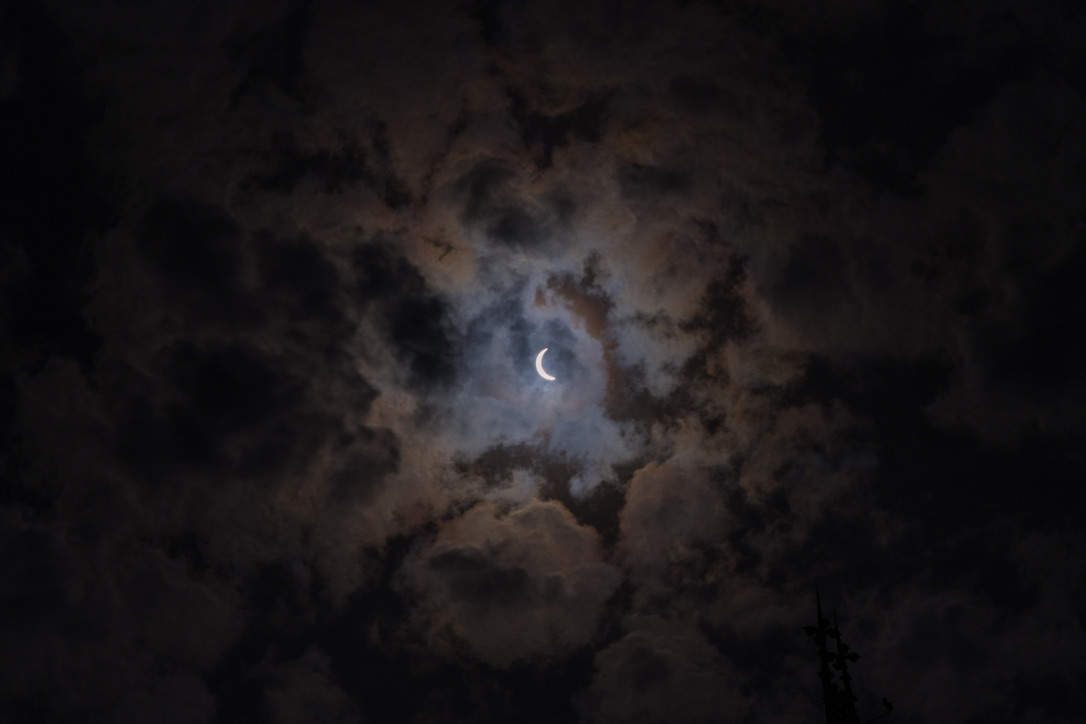Georgetown University students and community members gathered with blankets, friends and solar viewing glasses on Healy and Copley Lawns to observe a partial solar eclipse as it passed over Washington, D.C. April 8.
The 2024 eclipse, which crossed Mexico, the United States and Canada over the course of several hours, was most visible in D.C. around 3:20 p.m. with nearly 90% of the sun covered by the moon. The path of totality — the swath of North America where observers experienced a completely covered sun — missed Washington, though it covered various major cities including Dallas and Buffalo, N.Y.
Camber Vincent (SFS ’24) said the enormity of student engagement with the solar eclipse shocked him.
“I’ve been here for four years, and I don’t think I’ve ever in my life seen Copley and Healy as crowded as they were during the solar eclipse,” Vincent told The Hoya. “It’s an experience that you can’t really replicate.”
Christopher Cothran, an associate professor of physics, said the relative size of the moon to the sun impacts how viewers on Earth experience the eclipse.
“We have a pretty big moon by comparison to other moons in the solar system,” Cothran told The Hoya. “In relation to the sun, the moon seen in the sky happens to be large enough that it occupies a larger area in the sky than the sun does.”
Cothran said that he is particularly fascinated by the fact that the moon is not quite large enough to block out the light from the sun’s outermost atmospheric layer, called the corona, meaning that the eclipse revealed a solar atmosphere that is typically invisible to human observers.
“The eclipse is a natural way to see something that we wouldn’t normally see,” Cothran said.
The Georgetown University Astronomical Society, a club for students interested in outer space, hosted an eclipse viewing event on Healy Lawn, providing safe viewing glasses for students to protect their eyes from the sun’s intensity.
Owen Chbani (SFS ’25), the vice president of the Astronomical Society, said that total solar eclipses are especially intriguing because they are unique to Earth in the solar system, due to the unique placement of our moon and the sun in relation to the planet.
“Other planets in our solar system have eclipses, but they only block out like a third of the sun,” Chbani told The Hoya. “Our moon is really big and it’s in the perfect spot and distance to block out the sun, so we get that really cool effect.”
Sophia Chang (SFS ’24), co-president of the Astronomical Society, said the rarity of the solar eclipse in the contiguous United States also contributes to its significance.
“We’re not going to have another American solar eclipse until, I think, the 2040’s. So this is really a big event,” Chang told The Hoya.
This eclipse is the last total solar eclipse visible in the United States until Aug. 23, 2044, during which the eclipse will only be visible in three states. The next cross-country eclipse will occur Aug. 12, 2045.
Chang said that she and the rest of the Astronomical Society came prepared with a special telescope to help fellow Hoyas view the rare solar phenomenon.
“We brought the solar scope and the telescope with the solar filter on it from the observatory,” Chang said. “It was a hassle dealing with all the logistics, but it was so worth it.”
In ancient China, Jesuits gained renown for their ability to predict solar eclipses, helping them to legitimize their knowledge and beliefs as they sought to spread Christianity throughout China.
Citing the Astronomical Society’s decades-long history, as well as a Jesuit fondness for eclipses, Chang said that the event was especially resonant on the Hilltop.
“We, the Astronomical Society, have a really long history of solar eclipses before the club was made 52 years ago,” Chang said. “I’m really honored to be able to tell people about the work that was done.”
Some students left campus to experience the eclipse in the path of totality, like Frances Ross (CAS ’26), who journeyed to Dallas to see it.
“We found an empty field and brought picnics, solar eclipse glasses and things like that,” Ross told The Hoya. “We also had a camera and binoculars with solar film on them so we could take really good photos.”
Kate Nonnenkamp (CAS ’27), traveled to Ohio to see the path of totality.
“I know eclipses have been described as somewhat magical experiences,” Nonnenkamp told The Hoya. “There’s only so many opportunities, so I wanted to see it now, as soon as I can.”
Nonnenkamp said viewing the eclipse brought her together with others, especially her fellow Hoyas.
“We’re all seeing the same eclipse,” Nonnenkamp said. “I think that it means a lot to people and is really inspiring.”









